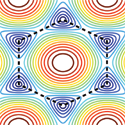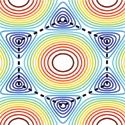Weak-coupling superconductivity from repulsive interactions
The possibility that superconductivity can occur in a system of fermions with only repulsive interactions has been known since the 1960s. The Hubbard model, which consists only of a local repulsive interaction between electrons hopping on a lattice, is the simplest realization of a system of interacting electrons.
Theorists have mainly focused on solving the Hubbard model where the repulsive interaction is at least comparable to the kinetic energy—the case most applicable to high- superconductivity. But even though the Hubbard model itself is simple, solving it to extract a reliable, much less a quantitative, electronic phase diagram in two or three dimensions remains a challenge.
In an article appearing in Physical Review B, Srinivas Raghu and Steven Kivelson from Stanford University and Douglas Scalapino from the University of California, Santa Barbara, both in the US, present an asymptotically exact solution for superconductivity in the repulsive Hubbard model in the limit in which the interaction is sufficiently weak compared to the kinetic energy. Raghu et al. employ a two-step renormalization group procedure for a variety of lattice systems (triangular, square, etc.,) to compute the critical temperature and pairing symmetry as a function of the electron density.
There are several advantages to Raghu et al.’s approach. It establishes that unconventional superconducting phases are ubiquitous at low enough temperatures, at least in the weak-coupling limit. Moreover, they can take into account complicated or multiband structures and longer-range interactions. Further, a possible way to retain asymptotic control of the calculation for interesting and highly experimentally relevant physics of competing phases is discussed in the paper. – Sarma Kancharla





